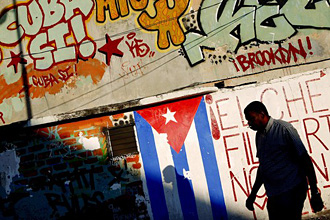
|
 |
 |
 Editorials | Issues | April 2008 Editorials | Issues | April 2008  
Cubans in Mexico: A Troubling Exodus
 Louis E.V. Nevaer - New America Media Louis E.V. Nevaer - New America Media
go to original


| | (LATimes) | | |
Merida, Mexico — Two months after Fidel Castro withdrew from public life in July 2006, a power struggle emerged in the Havana-Cancun-Miami triangle, where the underworlds of human trafficking and smuggling intersect.

With Raul Castro as Cuba’s leader, there is now an escalation of violence as the “Miami Mafia” and the “Havana Mafia” struggle for control, against the backdrop of Cancun, the opulent resort on Mexico’s Caribbean. It’s a power struggle for who will control the underworld consuming Cuba’s political economy.

The Cuban underworld has been flourishing on the margins of the economic embargo and political stalemate between Havana and Washington for nearly half a century. But with Fidel no longer on the scene, the illicit activities that characterized the Cuban “informal” economy are surfacing, and they are accompanied by violence.

Less than a month after Fidel announced he was temporarily relinquishing power, the Miami and Havana Mafias began their turf wars. At the end of July 2007, the body of Luis Lara, a Havana Cuban who sought political asylum in the United States in 2002, was found a dozen miles from Cancun, his body riddled with bullets. Three other bodies were found, all shot, in as many days. The murders were believed to be associated with a Miami-based human trafficking operation responsible for bringing thousands of Cubans to the United States.

Mexican officials grew alarmed; violence in Cancun has largely been confined to turf wars among drug cartels, but suddenly Cuban-on-Cuban violence is escalating as the conflicting interests of Miami Cubans (in human trafficking) and Havana Cubans (in drug and consumer goods) smuggling are converging. “All tourists are safe,” María Salmerón, spokesperson for the state prosecutor’s office in Cancun, told reporters. “These episodes are most likely the result of retaliation within organized criminal gang elements.”

The gruesome slaying brought attention to the profitable business the Miami Mafia operates out of Cancun. “There is concern on the part of our [immigration] service on how to deal with this new phenomenon,” Eusebio Romero, regional director of the Mexican Immigration Institute, said at the time. Mexican law requires that illegal aliens be deported, but not necessarily to their country of origin. Cubans have used this loophole to enter Mexico illegally, pay a fine of 10,000 pesos (roughly 910 USD), and then be given a 30-day visa to leave the country – which they do by boarding a bus to the border, crossing into the United States, and then requesting political asylum, which is automatically granted under American law.

Mr. Romero indicated that in 2007, more than 600 Cubans arrived in the Yucatan peninsula illegally, and that number is expected to increase significantly in 2008. “We lack the funds to increase patrols,” he said, adding that if Cubans are intercepted at sea, they are handed over to the Cuban Navy.

Mexican officials estimate that just over 9,000 Cubans have entered the United States through Mexico between 2005 and 2007. Each Cuban pays an average of 10,000 USD to the Miami Mafia for safe passage from Cuba to the U.S.-Mexico border.

“There is a silent exodus taking place from Cuba into [Mexico],” Ramon Sanchez, director of Democracy Movement, a Miami-based migrant advocacy group argues. “People in Cuba have no hope for change, and they want out.”

And it’s become a multimillion-dollar life and death business for the Miami Mafia. “We believe these people were executed by the Cuban-American mafia,” Quintana Roo State Attorney General Melchor Rodriguez told the media. “The presence of this organized crime organization is becoming as dangerous as drug cartels in that they have a lot of money and are armed.” | 
 | |
 |



